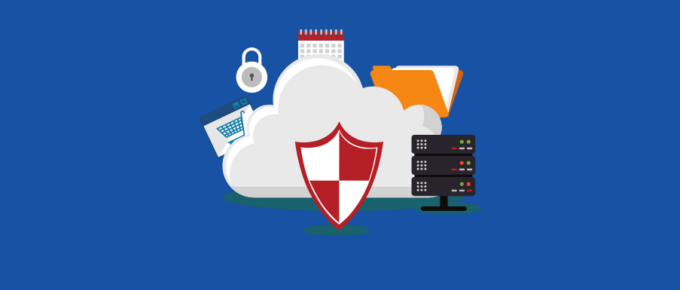
4 Reasons Why You Should Choose Google Cloud

Cloud computing origin can be traced back to the 1990s when telecommunication companies first included virtual private networks in their offerings.
Back then, the term “cloud” referred to computing space between a provider and an end-user.
The real revolution in the cloud computing field came in 1999 when Salesforce.com entered the picture. Salesforce.com is considered the pioneer of cloud computing, as we know today.
It was Salesforce that delivered enterprise applications to end-users through the Internet.
Soon after Salesforce.com, Amazon launched its web-based retail services in 2002. It provided a host of cloud-based services such as storage and computation.
Google jumped on the cloud bandwagon in 2008, when it introduced Google App Engine. It was in 2010 that the company introduced Google Storage.
The rising cost of electricity and demand for scalability is what lead the cloud revolution. Today, cloud computing is the buzzword. The public cloud services market stood at $227.8 billion in 2018 and is expected to grow by 50% in 2022.
The major players in the market are:
- Microsoft Azure
- Google Cloud Platform (GCP)
- Amazon Web Services (AWS)
- IBM Cloud
Although, GCP lags behind AWS regarding market share, it is building its muscle and trying to catch up fast. This can be seen from the fact that Google was able to score Spotify and Apple from Amazon.
Recently, Planet Labs, Lush Cosmetics, and Evernote also opted for Google cloud because it helped them meet their specific needs.
Here are four reasons why you should prefer Google Cloud over others.
Pricing

One of the reasons why Planet Labs shifted to Google was due to favorable pricing. What sets Google apart from Amazon Web Services is that it offers only one type of pricing plan, in which you pay monthly as per your usage.
The minimum usage is ten minutes, and it is rounded off to the nearest minute.
One attractive pricing feature that Google offers is Committed Use Discounts. Under this scheme, you can purchase “a specific amount of vCPUs and memory for up to a 57% discount off of regular prices” if you commit usage for either 1 or 3 years. An added advantage is that all virtual machines are included under usage.
Amazon, on the other hand, offers several complex plans. Plus, it rounds off to the nearest hour than a minute, which makes it expensive.
Moreover, Amazon offers committed discounts, but only for one virtual machine. Google has also committed to its users that it will pass on any price reductions that the company will achieve due to an enhancement of technology.
Speed

Although Amazon may have a greater extent of services to offer, Google leads Amazon regarding speed. Last year, Google announced that it is investing in the Faster Cable system through which it will be able to provide its Google Cloud and Google App customers speed up to 10Tbs (Terabits per second).
The cable lies under the Pacific Ocean, and Google is one of the six members that have access to it. The cable has connections to cover the entire US west coast and all the main cities in Japan. Also, it can connect with major hubs in Asia.
The speed considerably improves performance. As per TechCrunch, even though computing and storage are separate in Google Compute Engine, due to super-fast speeds, to the user, it seems as if it is one.
Higher speeds also affect costs and allow more data processing in less time. According to Google product manager Amit Aggarwal, networking costs have not gone down as much as storage and computing costs have. Hence, Google’s massive physical network is what gives it an advantage over other services.
Google is also known for providing low-latency network infrastructure.
Live migration

Compared to other services, Google offers live migration of virtual machines between host machines, which allows businesses to be up and running 24*7 without any hindrance in performance. Google introduced this service back in 2014. “We’re introducing transparent maintenance that combines software and data
Google launched this service back in 2014. “We’re introducing transparent maintenance that combines software and data center innovations with live migration technology to perform proactive maintenance while your virtual machines keep running.”
Live maintenance allows the company to repair and update software, including security-related programs, without rebooting the machines.
Other services, on the other hand, send you an email beforehand that your machines will be shut down and reassigned to another host.
One of the reasons why Evernote migrated to Google was so it wouldn’t have to deal with any lock-ins. Also, in a case of failures, the company automatically restarts the virtual machines, so they are online within minutes.
Big data

While Amazon Web Services is best known for its compute and infrastructure, Azure for its OS, Google stands out because of its data analytics.
Google’s innovative tools cloud warehousing such as Google BigQuery, and batch and real-time data processing tools such as Google Cloud Dataflow, and Google Cloud Dataproc can provide you with some great insights.
BigQuery, for example, is an entirely managed data warehouse that allows you to process massive amounts of data at super-fast speeds.
According to Google, its customers regard tools like BigQuery as “nearly magical” since what used to take hours can now be done within minutes.
Cloud computing is the talk of the town. The market is going to get more competitive as the companies learn to contain costs with their best practices.
In the 2017 Google Cloud Next conference in San Francisco, the company announced that its focus for the cloud would be data analytics and machine learning.
Google confirmed that its engineers had done 500 releases on the platform. The company has also carried out various partnerships with giants such as SAP and international bank HSBC that rely on big data analytics.
Google also revealed some new machine learning and artificial intelligence tools at the conference. Google may be lagging behind Amazon for now, but at the rate at which it is ramping up its efforts, it won’t be long before Google catches up.
If interested in learning Google Cloud, then I would recommend taking an online course offered by Coursera.
- Tagged in:
- GCP
More great readings on Cloud Computing
-
 8 Best Cloud Access Security Broker (CASB) SolutionsAmos Kingatua on April 28, 2022
8 Best Cloud Access Security Broker (CASB) SolutionsAmos Kingatua on April 28, 2022 -
 How to Become an AWS Cloud Practitioner in 2022: Courses and ResourcesNaman Yash on April 27, 2022
How to Become an AWS Cloud Practitioner in 2022: Courses and ResourcesNaman Yash on April 27, 2022 -
 Top 5 Distributed Tracing ToolsGeekflare Editorial on April 27, 2022
Top 5 Distributed Tracing ToolsGeekflare Editorial on April 27, 2022 -
 9 Developer-Friendly Hosting Platforms to Deploy SaaS ApplicationsChandan Kumar on April 27, 2022
9 Developer-Friendly Hosting Platforms to Deploy SaaS ApplicationsChandan Kumar on April 27, 2022 -
 G-Core Labs Hosting Review: Reliable Platform for Small to Big BusinessAmrita Pathak on April 26, 2022
G-Core Labs Hosting Review: Reliable Platform for Small to Big BusinessAmrita Pathak on April 26, 2022 -
 G-Core Labs Cloud Review: High-performing and Easy-to-use Truly Global Cloud PlatformAmrita Pathak on April 24, 2022
G-Core Labs Cloud Review: High-performing and Easy-to-use Truly Global Cloud PlatformAmrita Pathak on April 24, 2022










